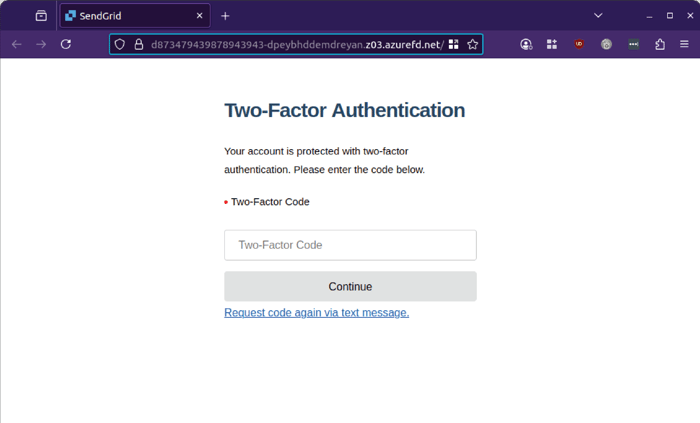MailGuard’s filters are intercepting a phishing run that impersonates Twilio SendGrid billing and support (Twilio is a software company that helps businesses to unify their data through its customer engagement platform). The lure is a simple HTML email with a single link. The first page asks for a username and password. The second page prompts for a one-time SMS code, a tactic designed to defeat multi factor protection by capturing the code in real time.
What the scam looks like
The email display name is 'Twilio' and comes from itsupport(at)tscti(dot)com, with the subject 'CASE#: 8383303958, advising that a 'recent paymen attempt declined' requesting that recipients 'update billing information', with a blue link that appears to reference SendGrid (a cloud-based email service provider (ESP) that helps businesses send marketing and transactional emails).Lure email: A plain text “Billing Operations Team at Twilio” message that urges you to update billing and links to what looks like app.sendgrid.com/...

Fake sign-in: A page styled as twilio SendGrid asks for “Username or Email” and “Password”. The address bar shows a non-SendGrid host on *.azurefd.net.

2FA prompt: A page titled “Two-Factor Authentication” asks for a code and even offers “Request code again via text message.”

How the scam works, step by step
- Click: The email link opens a counterfeit SendGrid login that looks credible.
- Credential capture: Anything entered in the username and password fields is sent to the attacker.
- 2FA capture: The follow up page requests your two factor code. Attackers use these codes instantly to log in as you.
- Account takeover: With valid credentials and a fresh code, criminals can change billing, rotate API keys, create new sender identities, and send large volumes of phishing from an account that receivers trust.
Why this tactic is effective
- The message is short and routine, which lowers suspicion.
- The link text looks like a real SendGrid path, but the page is hosted elsewhere.
- The MFA prompt gives false reassurance that the flow is genuine while harvesting the code.
Who is at risk
- Teams that use SendGrid for marketing or transactional mail
- Finance users who handle billing notices
- IT and marketing staff with elevated permissions in Twilio or SendGrid
Indicators to help your SOC
- Sender: itsupport(at)tscti(dot)com with display name “Twilio”
- Observed host: *.azurefd.net for fake login and 2FA pages
- Behaviour: credential capture followed by one time code capture
- Outcome: Twilio or SendGrid account takeover, new API keys, new verified senders, sudden sending spikes
If someone in your team clicked or entered details
- Reset the SendGrid password and enforce MFA with an authenticator app.
- Revoke active sessions, rotate API keys, and review recent key creation.
- Audit sender identities, webhooks, and suppression lists for changes.
- Check mailbox rules for forwards or deletes if the same email password was reused.
Stay Safe, Know the Signs
MailGuard advises all recipients of these emails to delete them immediately without clicking on any links. Responding or providing personal details can lead to identity theft, data breaches, and financial losses.
Avoid emails that:
- Aren’t addressed to you personally.
- Are unexpected and urge immediate action.
- Contain poor grammar or miss crucial identifying details.
- Direct you to a suspicious URL that isn’t associated with the genuine company.
Many businesses turn to MailGuard after a near miss or incident. Don't wait until it's too late. Reach out to our team for a confidential discussion by emailing expert@mailguard.com.au or calling 1300 30 44 30.
One Email Is All That It Takes
All that it takes to devastate your business is a cleverly worded email message that can steal sensitive user credentials or disrupt your business operations. If scammers can trick one person in your company into clicking on a malicious link or attachment, they can gain access to your data or inflict damage on your business.
For a few dollars per staff member per month, you can protect your business with MailGuard's specialist, 'zero zero-day' email security. Special Ops for when speed matters! Our real-time 'zero zero-day', email threat detection amplifies our client’s intelligence, knowledge, security and defence. Talk to a solution consultant at MailGuard today about securing your company's inboxes.
Stay up-to-date with MailGuard's latest blog posts by subscribing to free updates. Subscribe to weekly updates by clicking on the button below.







